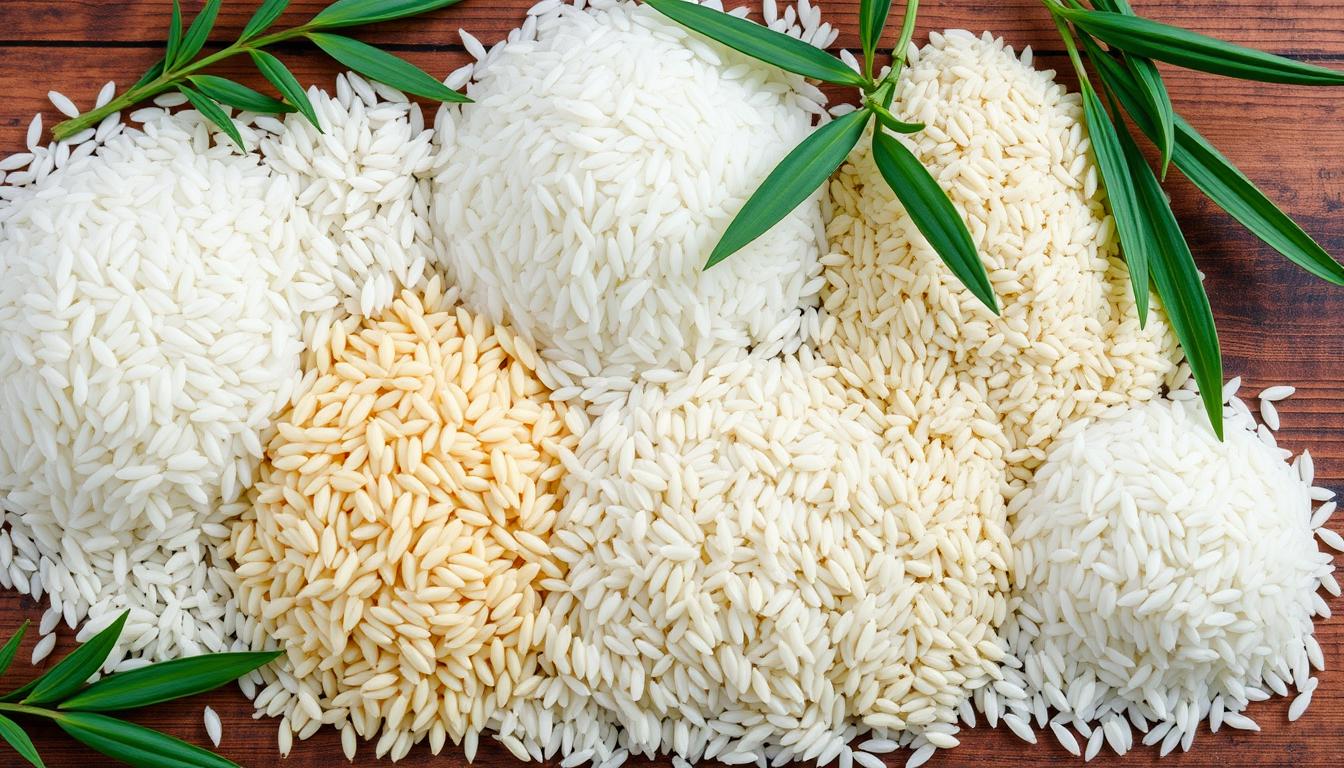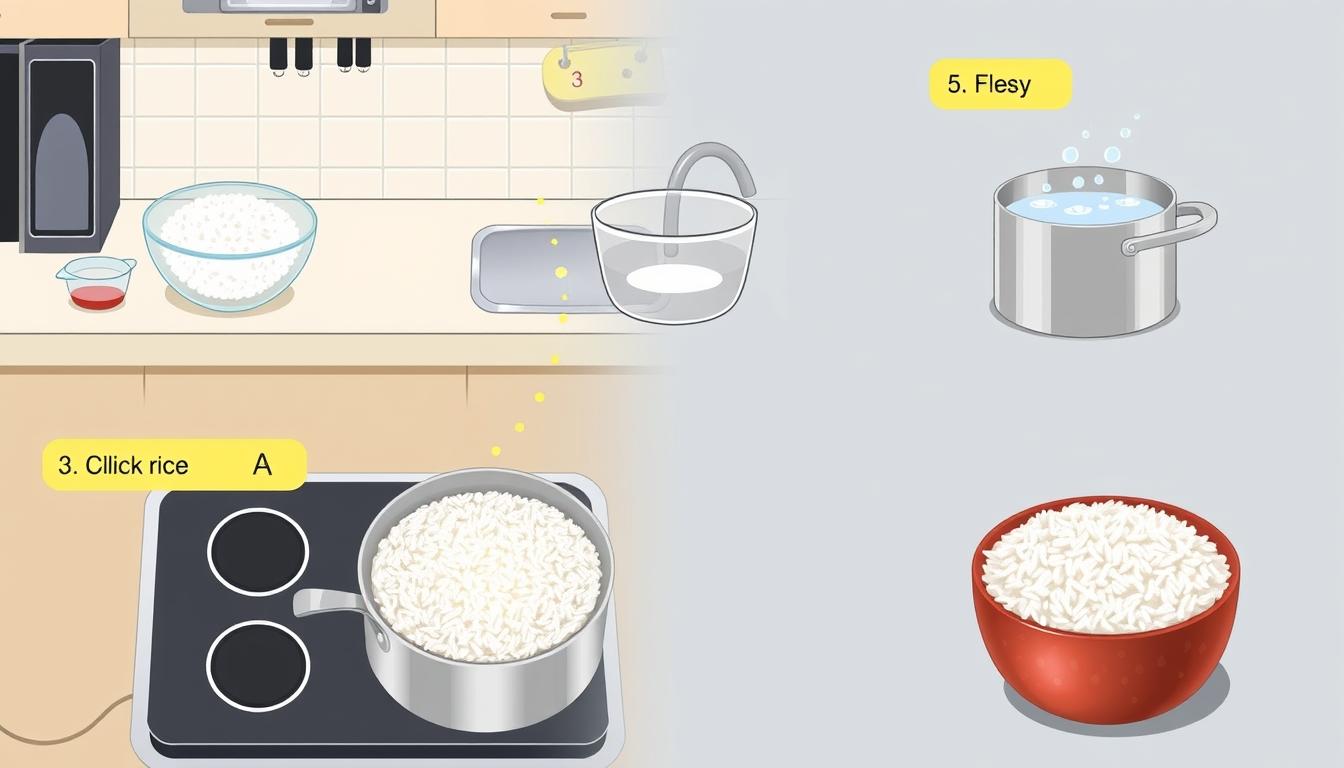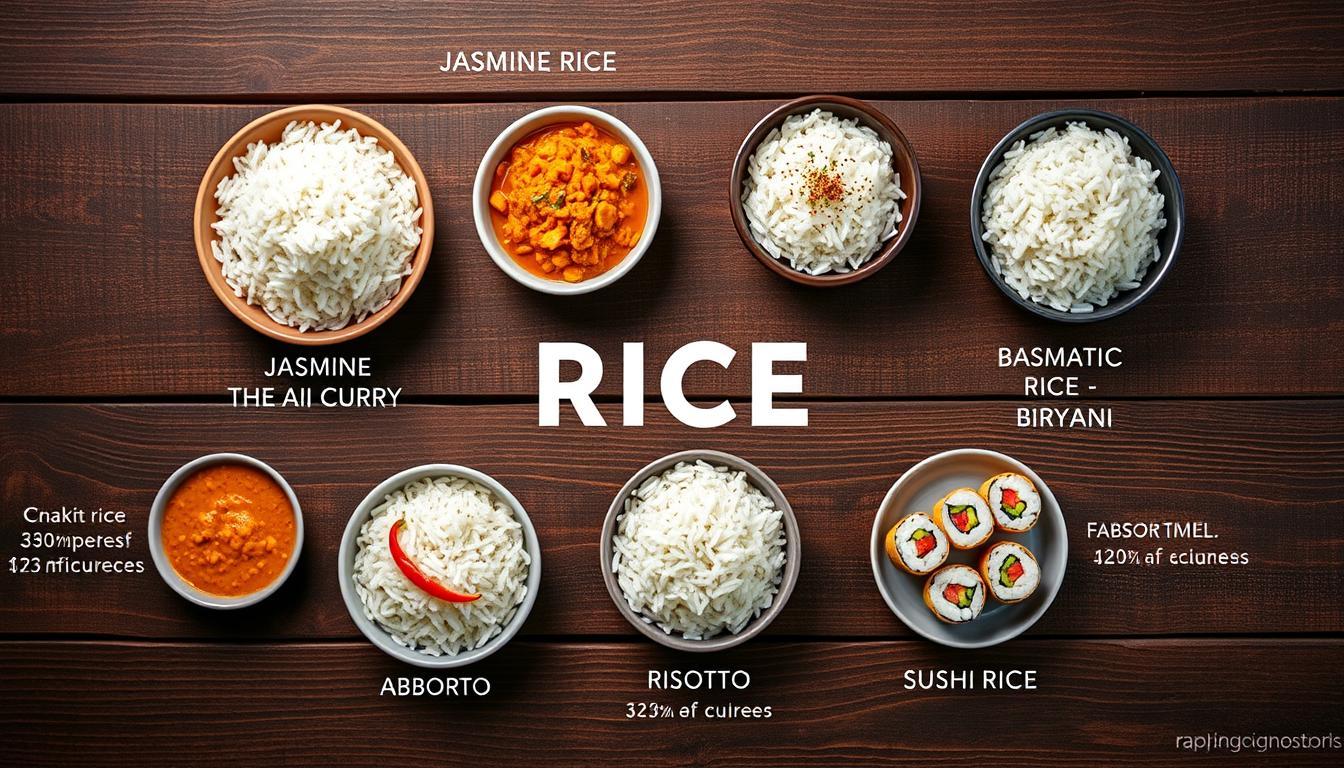Ever wondered why rice is a big deal in about 60% of global food? It’s because rice is versatile and loved everywhere. This guide explores how Basmati, Thai jasmine, and wild rice are special in their places.
Recipes use different rice types to bring out bold flavors. Each part of this guide offers new ideas for making rice a favorite. Get ready to see how rice brings depth and joy to your meals.
What Is International Rice Cuisine?
International Rice Cuisine is all about the many ways rice is prepared around the world. You’ll find hearty bowls in Asia, festive plates in Europe, and comforting meals in the Americas. Rice is a key part of our daily nutrition and creative cooking.
Overview of Rice in Global Cultures
Rice is a main ingredient in dishes like paella, biryani, plov, and bibimbap. It’s a staple for over half of the world’s people, connecting different cultures. The U.S. produces 20 billion pounds of rice each year, adding to local flavors and celebrating cultural fusion.
Historical Significance of Rice
Rice has shaped trade and local economies, from Asia’s paddy fields to North America’s marshlands. In Charleston, Carolina Gold rice was key to the dining scene. Black cooks, like those of the Gullah Geechee tradition, showed its cultural importance. Their work led to many rice dishes that represent community and heritage across the globe.
How Is Rice Prepared in Different Countries?
Many places have their own way of making rice into delicious meals. Some keep it simple by steaming or stir-frying to keep the taste fresh. Others simmer it with herbs and legumes to make bold dishes. Each method celebrates local tastes, history, and resources.
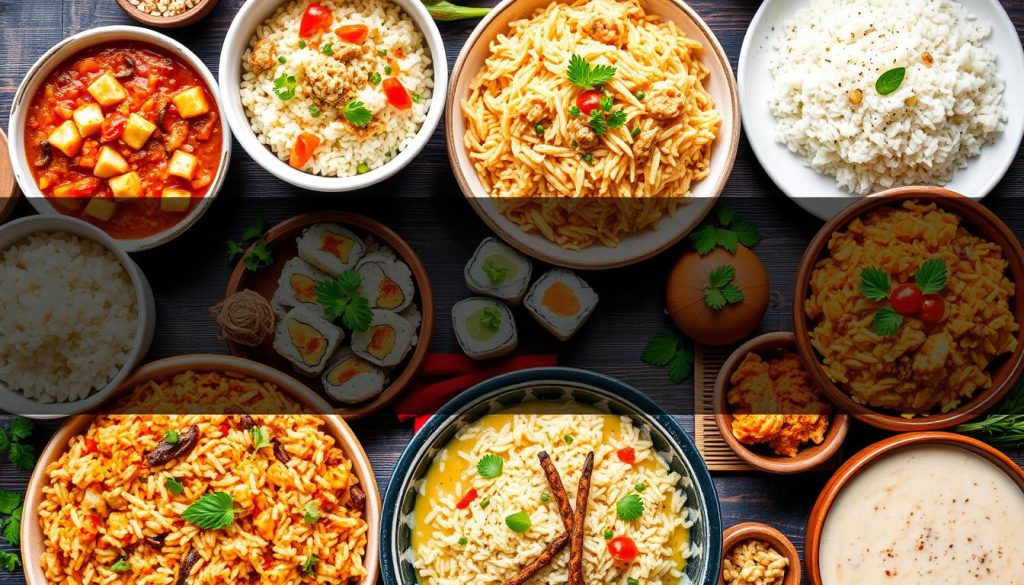
Cooking Techniques Around the World
In Asia, dishes often use light steaming or quick stir-frying. This brings out the rice’s softness and brightens the colors of vegetables or proteins. In Latin America, rice is simmered with spices and chopped veggies, making meals that reflect the area’s cooking traditions. Some families even sauté rice before boiling to add more flavor.
Regional Recipes to Try
Fan tuan from Taiwan is filled with pickled veggies and egg, rolled up for a tasty snack. Onigiri from Japan shapes sticky rice into fun shapes for lunch or snacks. Jollof, a West African dish, mixes tomatoes, onions, and spices into a flavorful one-pot meal. These dishes show how rice can be transformed into many different flavors. Whether steamed, fried, or rolled, each method adds its own special touch.
What Are Popular Rice Dishes?
Many rice-based recipes are loved for their varied tastes and local flavors. Around the world, cultures have created special dishes that make simple grains into unforgettable meals. These dishes show how simple ingredients, herbs, and meats can create culinary wonders.
Examples of Iconic Rice Dishes
Sushi from Japan mixes vinegared rice with fresh fish or veggies. Paella, made with Success® White Rice and saffron, comes from Spain and has seafood, poultry, and veggies. Jambalaya from Louisiana uses chicken, spicy sausage, and long-grain rice cooked together. Biryani, a favorite in India, combines basmati rice and spices like cloves and cinnamon.
Flavor Profiles by Region
Seasonings, fats, and local produce make each dish special. Some places love smoky peppers, while others prefer citrusy or creamy sauces. These differences make regional dishes unique and exciting for everyone.
| Country | Dish | Main Ingredients |
|---|---|---|
| Spain | Paella | Bomba rice, saffron, seafood, vegetables |
| Japan | Sushi | Vinegared rice, fish, vegetables, seaweed |
| United States | Jambalaya | Long-grain rice, chicken, sausage, spices |
| India | Biryani | Basmati rice, fragrant spices, meat |
How Do You Use Rice in International Recipes?
Start by picking the right grains and mixing them with exciting seasonings. Many cultures love rice, like Singapore’s Hainan Chicken Rice or Guyana’s Cook-up Rice. You can make these dishes your own by choosing quality ingredients and finding the right spice balance. Serious Eats has 16 Chicken With Rice Recipes for a cozy dinner.
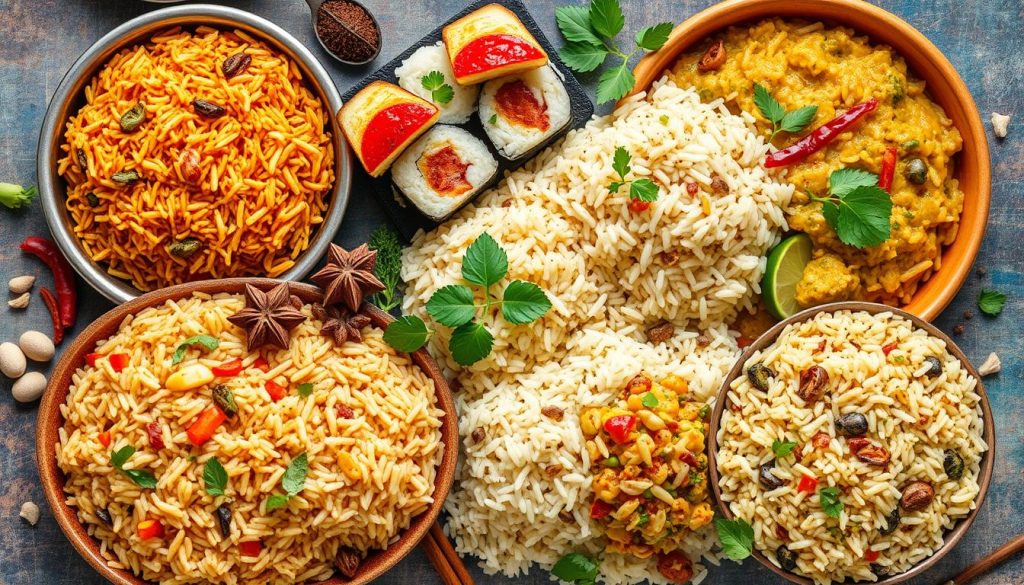
Essential Ingredients for Rice Dishes
Fresh herbs add a burst of flavor, while legumes and veggies complete your meal. Proteins like shrimp, chicken, or tofu go great with spices that bring out rice’s taste. A little chili flakes or cumin can make a dish unforgettable. Try using stock instead of water for more flavor.
Cooking Rice: Tips and Tricks
Rinse grains like basmati or jasmine to get rid of extra starch. Measure water carefully and keep the lid on while it cooks. Avoid overcooking by watching the time and moisture. Season slowly and taste as you go to prevent blandness. With practice, your rice dishes will always be a hit.
What Types of Rice Are Used in International Cuisine?
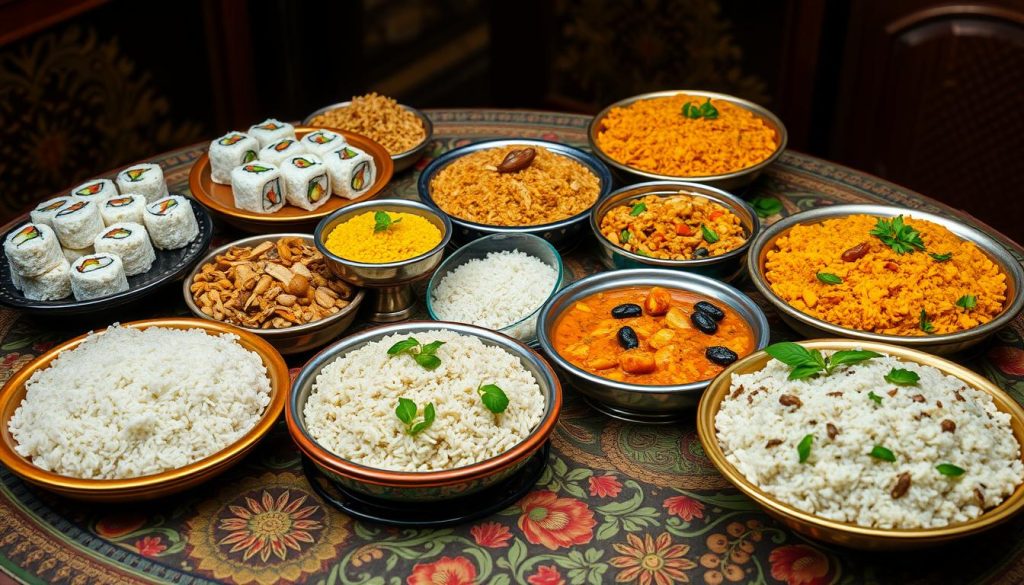
Rice is more than just a grain. It comes in over 40,000 varieties, each playing a role in global food traditions. These varieties offer unique tastes and textures, making multicultural rice dishes more exciting.
Basmati, jasmine, arborio, and wild rice are just a few examples. They add depth and personality to your dishes. Some have a floral aroma, while others are creamy and melt in your mouth. This variety lets you explore different cuisines in your cooking.
Varieties of Rice Commonly Used
| Rice Type | Key Feature | Popular Dish |
|---|---|---|
| Basmati | Long-grain, fragrant | Pilaf |
| Jasmine | Soft, aromatic | Stir-fries |
| Arborio | Creamy consistency | Risotto |
| Brown Rice | High fiber, nutty | Whole-grain bowls |
| Wild Rice | Nutty flavor | Soups and salads |
Nutritional Differences Among Rice Types
Brown rice keeps its bran and germ, giving it more vitamins and fiber than white rice. Black or forbidden rice is packed with antioxidants, boosting your health. Each type meets different dietary needs, making it easy to create nourishing multicultural rice dishes.
How Does Rice Impact Global Gastronomy?
Rice has a big impact around the world. It’s found in 62-66% of global trade, with jasmine and basmati making up 23-25%. This trade links cultures, shapes trade, and boosts economies. People love trying exotic rice dishes to discover new tastes and textures.
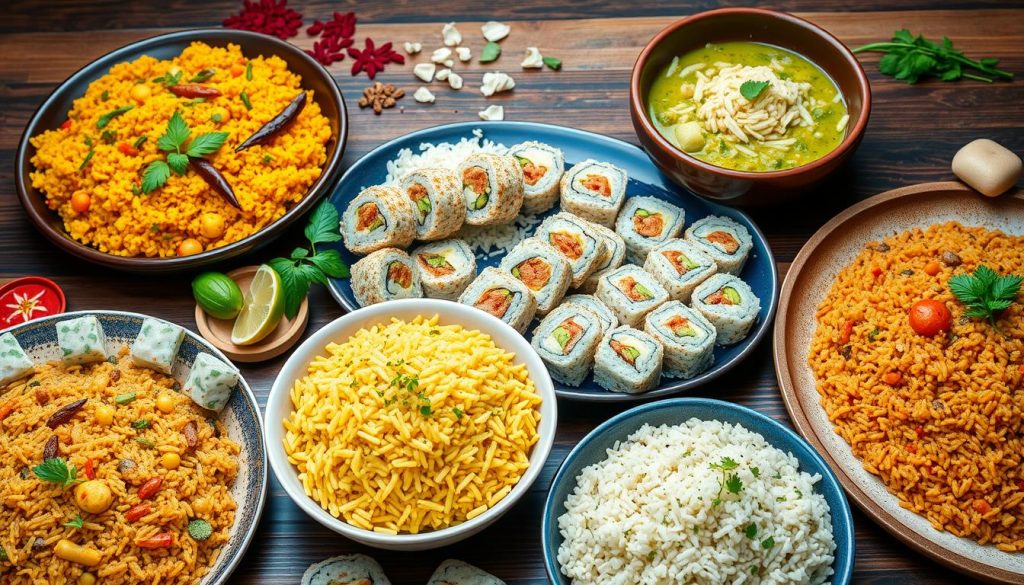
In Asia, rice is a main food. In Latin America and Africa, it goes with stews or beans. Rice’s growth and trade have changed diets and traditions everywhere. Each place’s climate and farming methods affect how rice helps communities.
- Indica rice: Higher yields, tropical regions
- Aromatic rice: Signature scent, central to specialized dishes
- Japonica rice: Cooler climates, lower yields
- Glutinous rice: Distinct texture, key in certain desserts
| Rice Type | Main Producers | Share in Global Trade | Key Attribute |
|---|---|---|---|
| Indica | Tropical/Subtropical Nations | 62-66% | High Yields |
| Aromatic (Jasmine/Basmati) | Thailand, Vietnam, India | 23-25% | Fragrant Profile |
| Japonica | Japan, Parts of China | 9-10% | Cold-Resistant |
| Glutinous & Specialty | Thailand, Vietnam | 2-3% | Sticky Texture |
The Role of Rice in Traditional Meals
Rice is a must at every big event, from family reunions in Asia to community celebrations in Africa. It’s often the main dish, showing off local ingredients and spices.
Rice as a Staple Food
Rice is a key food for many families worldwide. It fills bellies and helps ensure food security across cultures. It’s a common thread on tables everywhere.
What Are the Health Benefits of Eating Rice?
Rice is a staple for nearly half of the global population. Whole-grain varieties retain the bran and germ, which means more fiber and nutrients. This helps your body maintain balanced energy levels and supports digestion. Many international rice specialties become nutrient-dense when paired with fresh vegetables and lean proteins.
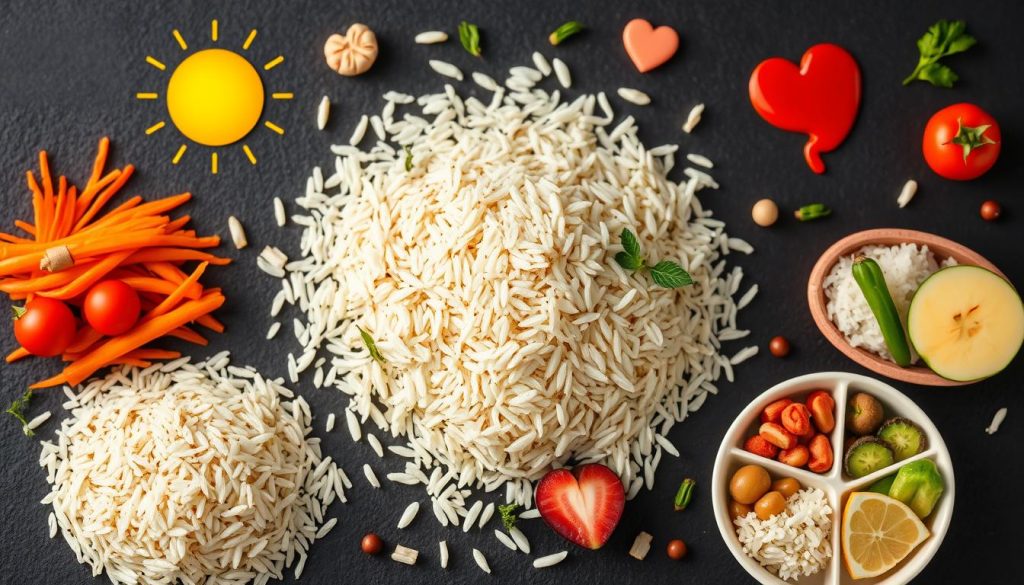
Nutritional Value of Rice
Brown rice has a lower glycemic index than white rice. A half-cup serving provides around 108 calories, 3 grams of protein, and 2 grams of fiber. It also contains essential vitamins like thiamin and niacin. Fiber aids in weight management, while antioxidants in brown rice may help reduce cancer risk.
- Brown rice: Higher in fiber and nutrients
- White rice: Lower fiber content
- Specialty rice varieties: May include extra antioxidants
Health Considerations with Rice Consumption
Moderate portions help you avoid excessive carbohydrates. Studies link high intake of refined white rice to higher diabetes risk. Combining rice with leafy greens, beans, or fish can create balanced meals. This supports a varied diet and lets you enjoy international rice specialties without compromising your health.
How Can You Incorporate Rice into Your Diet?
Rice is a food loved by many around the world. It’s estimated that about 60% of people eat it every day. A big bag of rice costs less than $9 and gives you over 200 servings. This makes it easy to save money without losing flavor.
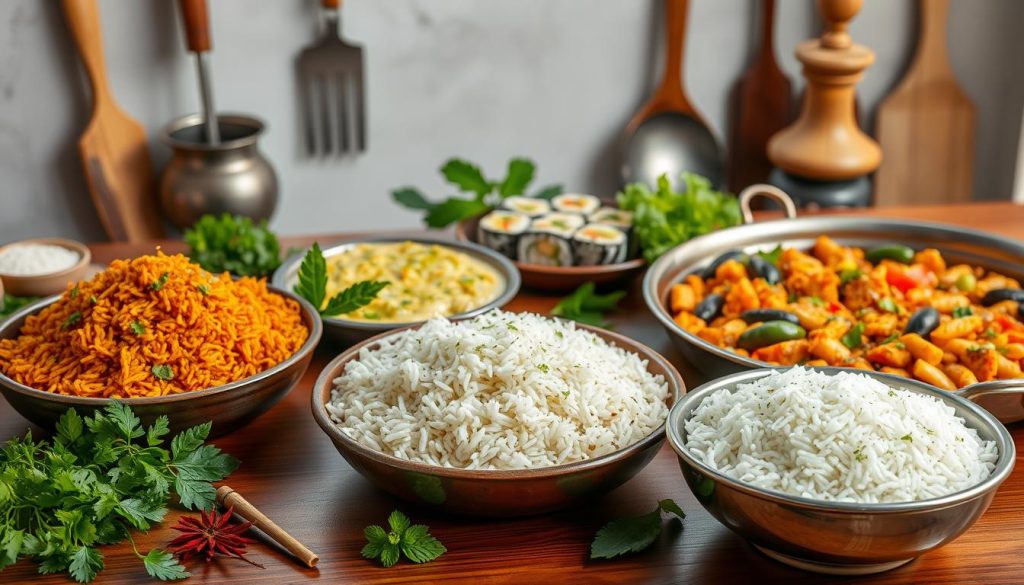
Tips for Everyday Cooking
White or brown rice can be cooked on the stovetop or in a rice cooker. White rice has fewer calories and is soft. Brown rice, on the other hand, has more fiber. Pairing rice with beans or lean proteins makes meals complete and nutritious.
Creative Ways to Use Leftover Rice
Turn leftover rice into fried rice with veggies, or make arancini for tasty snacks. These recipes add variety to your meals and are easy to make. Leftover rice is also great in lunch boxes, soups, and casseroles. It helps reduce waste and saves time.
What Are Some Common Misconceptions About Rice?
Some think rice is just empty carbs or that it makes you gain weight. But, it’s really about how much you eat and how you cook it. Rice is full of fiber and vitamins, making it a key part of meals worldwide.
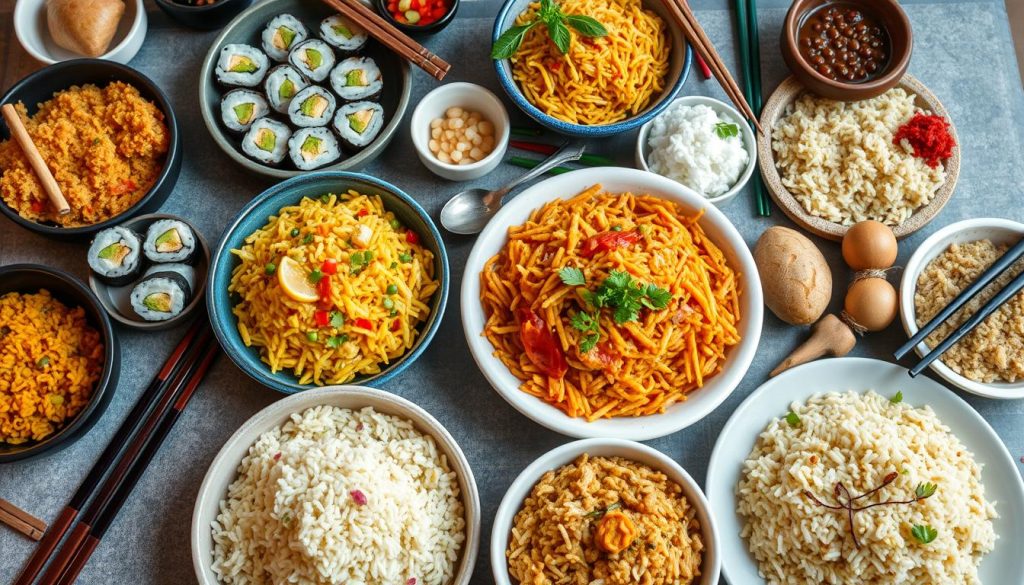
Waqar Rice Mills says refined grains have fewer vitamins than whole grains. Rinsing rice also removes extra starch, making it taste fresher and less sticky. The right water ratio is key to getting the perfect texture.
Debunking Myths About Rice
Many think eating rice ruins a healthy diet. But, you can control your intake by balancing it with other foods. Choose whole grains for more nutrients. And, don’t use too much water when cooking white rice to avoid mushiness.
Understanding Rice’s Role in Modern Diets
Rice is a staple in families around the world. It can be a small side or a main dish, fitting into your diet goals. Focus on fiber-rich types and portion sizes to enjoy rice without losing balance.
How Are Rice Dishes Served and Enjoyed?
Rice dishes are served in many ways around the world. In East Asia, people share bowls, showing unity. They scoop food onto their plates or eat from the bowl in casual places.
In Africa and Latin America, big bowls sit in the middle of the table. This encourages everyone to share and bond over food.
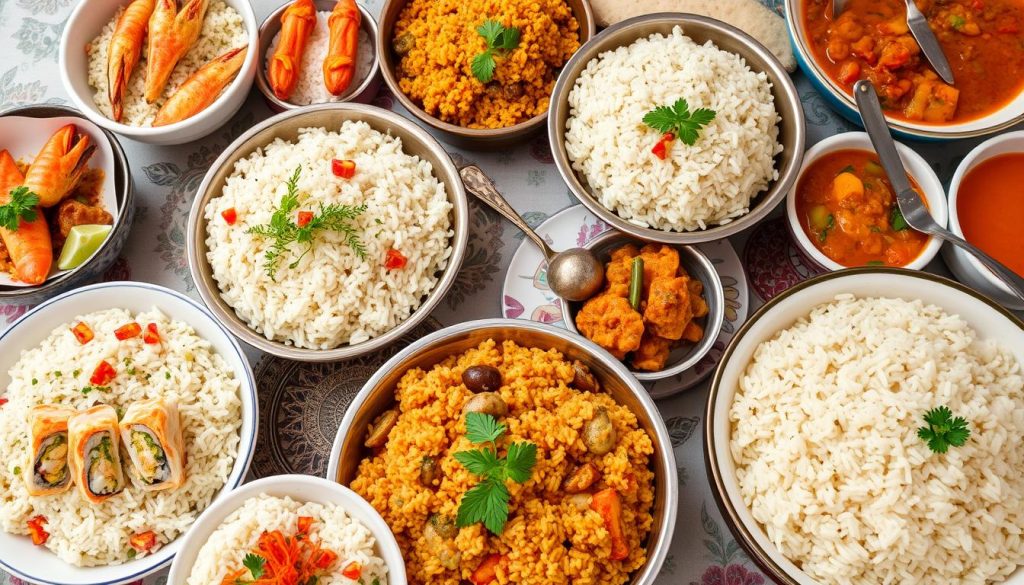
Etiquette for eating rice varies by region. But, it’s all about using utensils right and sharing food thoughtfully. Some places value not wasting a single grain, showing how much rice is cherished.
Cultural Etiquette Around Rice Consumption
Chopsticks are essential in Chinese or Japanese meals. You lift the bowl to your mouth to keep food neat. In Africa, bread or the right hand is used to take rice from shared plates.
In Latin America, buffets are common. People make their own plates with various toppings and sides.
Popular Accompaniments to Rice
Beans, sauces, stir-fried veggies, or pickled items make rice dishes better. Spicy chutneys go well with Indian food, while kimchi pairs with Korean rice. A bit of chili oil, fresh herbs, or citrus can enhance flavors.
This inspires you to try these ideas at home. It makes your meals more authentic and enjoyable.
What Are the Sustainability Practices in Rice Farming?
Rice farming has a big impact on land and water. Growers use a lot of water to flood fields, using almost 30% of the world’s fresh water. Traditional farming also leads to about 10% of man-made methane emissions.
Experts say the rice supply could drop by up to 20% by 2050 if farming doesn’t change. This is why new solutions are being found. They aim to help both farmers and those who buy ingredients for global rice recipes.
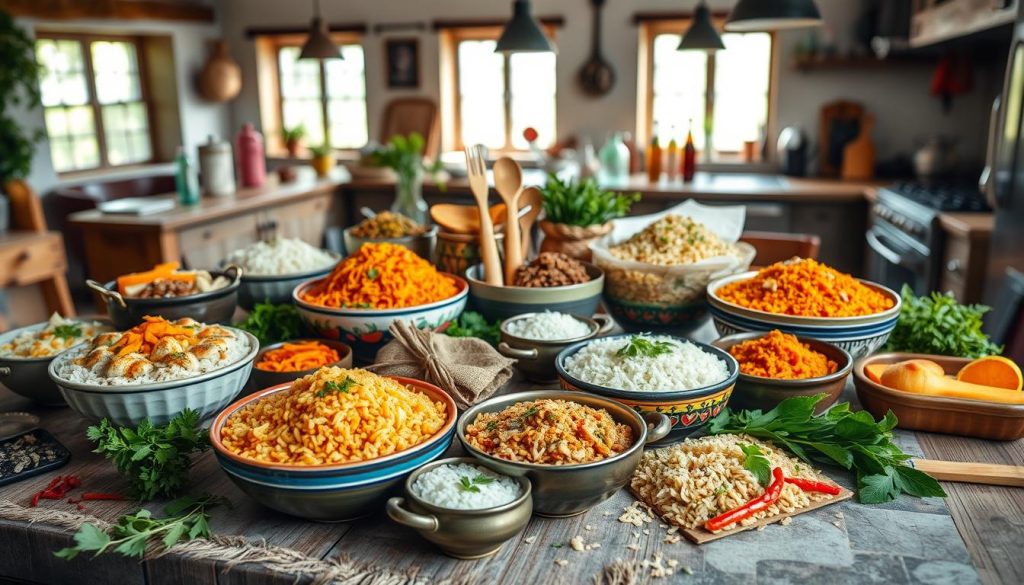
Environmental Impact of Rice Cultivation
Intensive farming needs careful planning to protect nature. Over 140 million smallholder farmers depend on rice for food and work. So, finding efficient ways is key.
In the U.S., rice farming has led to new methods. These methods reduce soil erosion and keep biodiversity on 2.8 million acres of farmland. This effort helps keep a steady supply of rice for families and communities.
Sustainable Alternatives and Practices
System of Rice Intensification (SRI) is used in over 60 countries. It can increase yields by 20-50% and cut water use by up to 40%. Planting rice that can handle changing weather is also important.
Choosing fair-trade or eco-certified rice helps farmers use better methods. By doing this, you support healthier fields and communities. You also help make sure the rice in your recipes comes from responsible sources.
What Are the Cooking Equipment Essentials for Rice?
Getting your perfect bowl of rice starts with the right tools. You need a strong pot or pan with a tight lid. This lets you control heat and moisture. For authentic Spanish flavors, use a paella pan to get crisp edges.
Midway through cooking, stir gently with a wooden spoon. This helps keep the rice consistent.
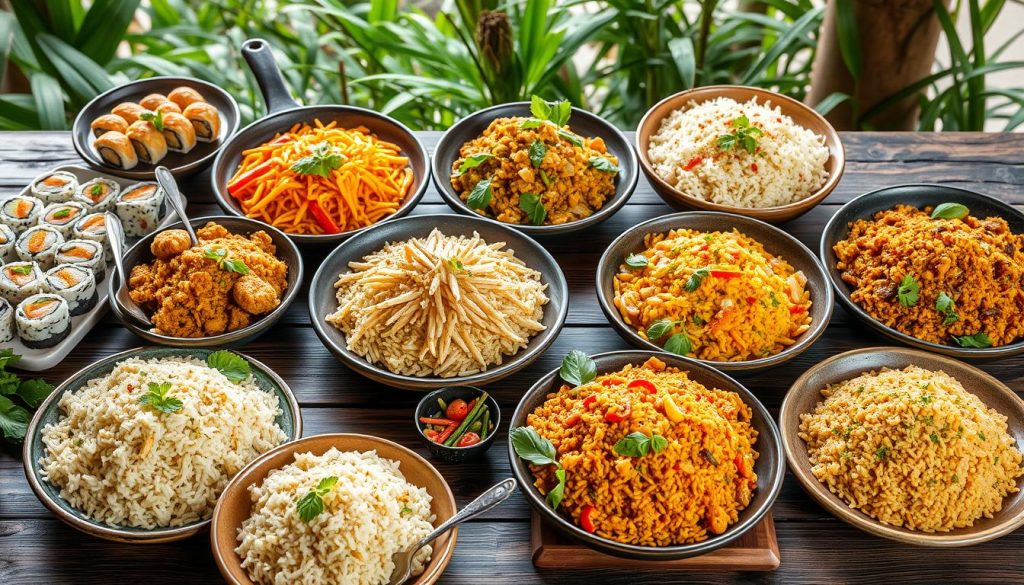
Must-Have Tools for Cooking Rice
Some cooks stick to simple stovetop methods. Others use multi-cookers or Dutch ovens for more complex dishes. Non-stick surfaces make cleaning up easier and keep grains intact.
Look for digital timers. They help you serve diverse rice meals with perfect results.
Recommended Rice Cookers
Brands like Zojirushi and Aroma are great for everyday use. Finding a model that fits your budget is easier when you know what to look for. Rice cooker prices can vary by store and model.
| Brand/Model | Key Feature | Price Range |
|---|---|---|
| Zojirushi Basic | Advanced Fuzzy Logic | $33-$50 |
| Aroma Classic | Quick Cook Setting | $30-$50 |
| Panasonic Deluxe | Digital Timer | $33-$50 |
These modern appliances make exploring diverse rice meals easy. They ensure consistent cooking times. This way, you can focus on flavors without worrying about undercooked grains.
How Do You Customize Rice Dishes to Your Taste?
Exploring world rice flavors can turn simple recipes into exciting dishes. Swapping coconut milk for water can make rice creamy. McCormick saffron adds a vibrant color that makes the dish pop.
Don’t be afraid to try new things in the kitchen. Mixing rice with other grains or legumes can lead to interesting textures and tastes.
Substitutions and Additions
Adding quinoa to your rice can boost the protein content. Lentils or chickpeas add fiber. Chopped broccoli or carrots bring freshness. This mix keeps your dishes exciting.
- Mix white rice with wild rice for a firmer bite
- Combine rice and quinoa for diverse textures
- Stir in vegetables during the final minutes of cooking
Flavoring and Seasoning Options
A little paprika or cumin can add bold flavors. Lemon juice can brighten the dish. Make sure to adjust cooking times so each ingredient is perfect.
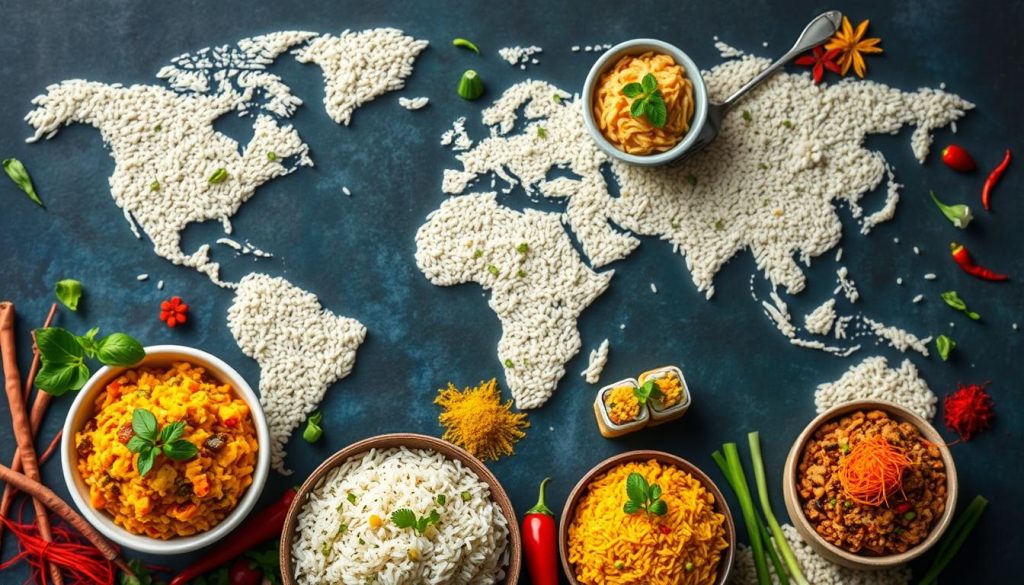
| Ingredient | Enhancement |
|---|---|
| Thai Kitchen Coconut Milk | Creates a creamy, tropical taste |
| McCormick Saffron | Brings a rich hue and subtle aroma |
| Fresh Herbs (Basil, Parsley) | Lifts overall flavor with light, herbal notes |
| Roasted Garlic Paste | Adds depth and savory complexity |
How Is Rice Integrated into Festivities and Celebrations?
Rice plays a big role in cultural traditions, bringing people together. It’s found at weddings, holidays, and even birthdays. Families use special rice dishes to show abundance and unity.
Rice Dishes for Special Occasions
In Latin America, sweet arroz con leche is a hit at big events. Indian weddings feature biryani, with its rich spices and grains. Japan celebrates New Year with mochi desserts.
Each place has its own twist, shaped by its history.
Cultural Significance of Rice in Festivals
In many Asian weddings, guests throw rice at the newlyweds for luck. In Hindu weddings, the couple shares rice to promise care for each other. Pongal in India is a sweet dish that honors farmers.
These traditions show the strong connection between communities and rice dishes worldwide.
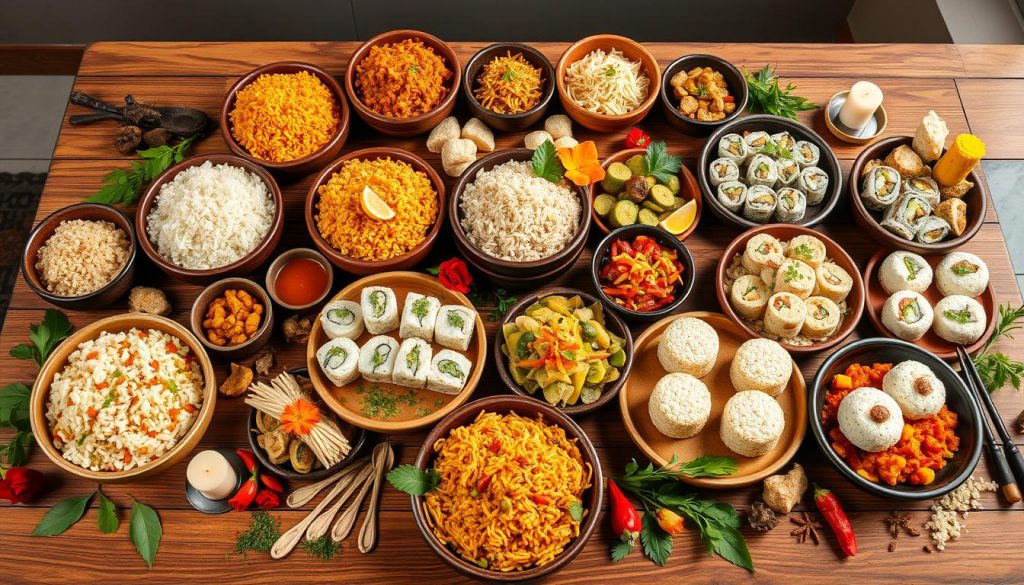
Where Can You Explore International Rice Cuisine Locally?
Exploring neighborhood eateries can awaken your taste for new flavors. You might find unique dishes like Lao sticky rice, known as khao niao. This special rice is found in Laos’ mountains and often goes with Larb or Tam Mak Hoong. Local restaurants might bring in grains from China, India, or Thailand to offer the unique textures of over 40,000 rice varieties.
Many chefs in the U.S. now use aromatic spices and traditional methods to celebrate exotic rice. You can try bibimbap or biryani, dishes with centuries of history. Some places even serve sticky rice desserts, mixing fruit and coconut milk for a sweet treat.
Finding International Rice Restaurants
Look for big names like Din Tai Fung or Benihana for international rice dishes. But don’t miss out on family-run places. They often have hidden gems with comforting flavors. Exploring menus can lead to fresh takes on authentic rice dishes.
Participating in Cooking Classes or Workshops
Hands-on classes let you learn techniques from around the world. Local culinary schools might teach you how to make sushi rice or paella. Smaller workshops focus on steaming sticky rice and pairing it with Jaew Bong. Each class boosts your confidence in making fragrant bowls at home.
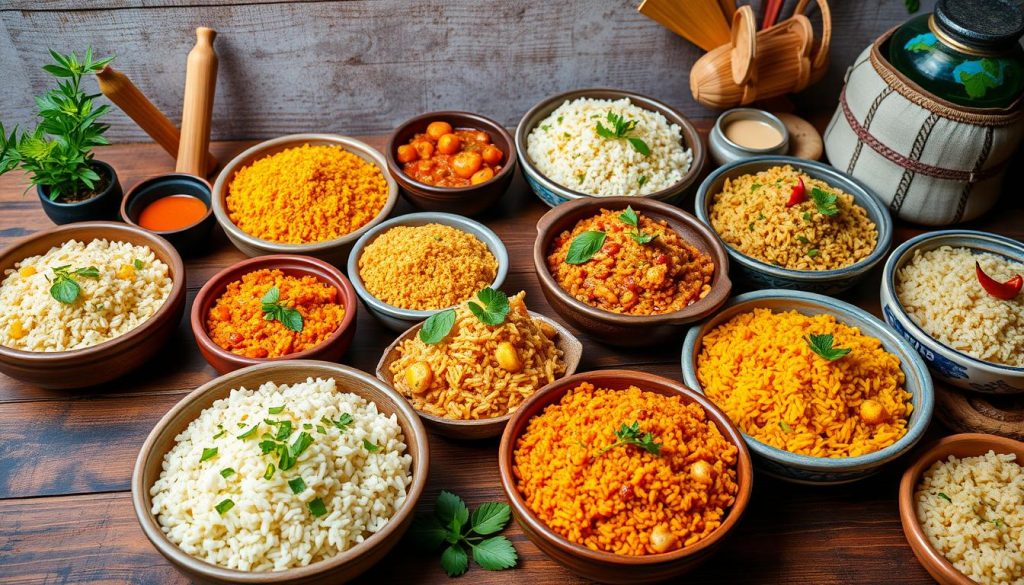
| Workshop or Dish | Origin | Key Flavor Profile |
|---|---|---|
| Biryani Class | India | Aromatic & Savory |
| Paella Spotlight | Spain | Saffron & Seafood |
| Sticky Rice Demo | Laos | Glutinous & Subtle |
| Bibimbap Tutorial | Korea | Spicy & Fresh |
What Resources Can Help You Learn More About Rice Cuisine?
Rice is a key part of diets around the world. About 90% of it is grown in Asia, and it’s also popular in the United States. To learn more, check out the USDA’s Economic Research Service. They have a Rice Outlook report that covers global market trends.
Consumer Reports also offers advice on eating rice safely. They talk about how to avoid arsenic and pesticides in rice.
Cookbooks Focused on Rice Dishes
There are many cookbooks on rice dishes from different cultures. You can find ones on Spanish paella, Japanese sushi, or Indian biryani. These books give you cultural insights and step-by-step recipes for both old and new dishes.
They help you get better at working with different types of rice.
Online Tutorials and Courses
Platforms like MasterClass have chefs teaching you how to cook rice. They show you how to rinse, soak, and cook it right. YouTube channels also offer live cooking videos to help you learn.
With these tools, you can improve your rice cooking skills. You can even make international rice dishes at home. And you’ll always find new ways to enjoy this important grain.
Source Links
- International Rice Dishes From Around the World | Mahatma® Rice
- 25 Rice Dish Recipes From Around the World
- A Guide To Rice Types Around The World
- Rice Is Everything: A Celebration of the World’s Most Popular Food
- 40 Rice Dishes From Around The World | How To Cook.Recipes
- Delicious Rice Recipes From Around the World | Minute® Rice
- How Rice Is Cooked in Different Countries Around the World
- Exploring Rice in Food Across Cultures
- Part IV – Rice in Cuisine
- List of rice dishes
- Top 10 Most Searched Rice Recipes | Success® Rice
- 28 Rice Dishes Around The World You Need To Try – Tasting Table
- International chicken and rice dishes
- Around the World in Rice: 7 Traditional Rice Dishes
- A Guide To Rice Types Around The World
- A Guide to Rice Types Around the World
- USDA ERS – Rice Sector at a Glance
- THE GLOBAL IMPORTANCE OF RICE – DFGRUPO
- Rice
- Health Benefits of Rice
- Safe and Healthy Rice
- 9 Healthy Ways to Use White Rice, According to a Dietitian
- Beans + Rice = A Complete Protein for Global Nutrition
- Whole Grain Goodness: Incorporating Basmati Rice into Your Diet
- Myths and Truths about Cooking Rice – Viet World Kitchen
- Myths vs. Facts: Debunking Common Misconceptions About Rice
- Debunking Rice Myths: 7 Essential Facts You Must Know – Vajrateja Rice
- The Fascinating World of Fried Rice – Lucky Kitchen Chinese Cuisine
- The Deep, Winding History of Rice Across the African Atlantic Diaspora
- The Art of Rice: Exploring Regional Dishes from Around the Globe
- Here’s Why Sustainable Rice Cultivation Is Better For The Environment | Freerice
- Sustainability Report
- Adopting agriculturally sustainable practices in rice cultivation
- Part III – Cooking Rice
- The Kitchen Starter Kit: Essential Tools for Every Cook
- 26 Kitchen Products Every Home Cook Should Own in 2025
- Spice Up Your Rice: How to Make White Rice Taste Better 🍚 | Mediocre Chef
- How to Add More Texture (and Flavor) to Your Next Pot of Rice
- Home Cook Dishes Out Simple Ways To Upgrade Boxed Rice – Food Republic
- Rice and Cultural Significance: Symbolism and Rituals
- The History and Culture of Rice Cuisine in Japan
- The Significance of Rice in Makar Sankranti and Pongal Festivals | – Times of India
- The Delightful World of Lao Sticky Rice: Exploring an Authentic Menu Bursting with Flavor
- 75 International Rice Recipes from Around the World
- Visit to the International Rice Research Institute
- USDA ERS – Rice
- Rice
